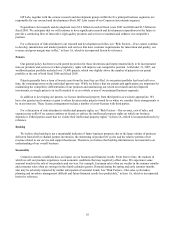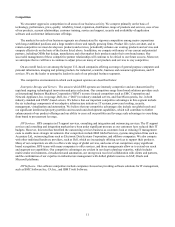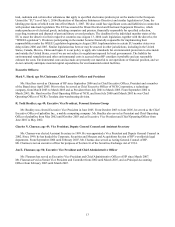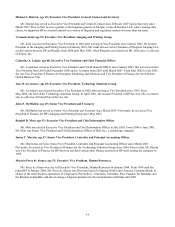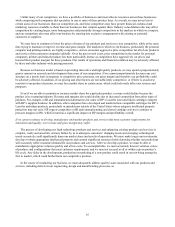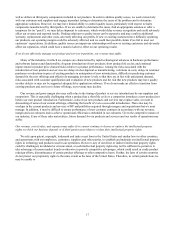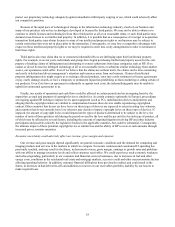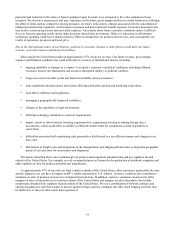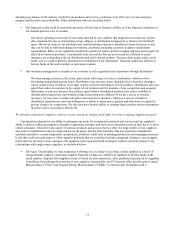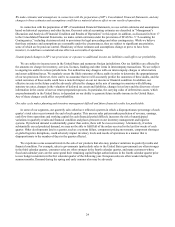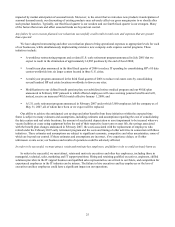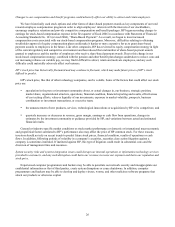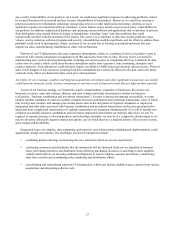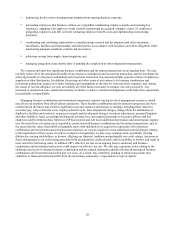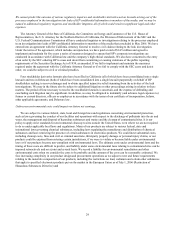HP 2007 Annual Report Download - page 33
Download and view the complete annual report
Please find page 33 of the 2007 HP annual report below. You can navigate through the pages in the report by either clicking on the pages listed below, or by using the keyword search tool below to find specific information within the annual report.payments and reduction in the value of leased equipment upon its return to us compared to the value estimated at lease
inception. We also have experienced, and may experience in the future, gross margin declines in certain businesses, reflecting
the effect of items such as competitive pricing pressures, inventory write-downs, charges associated with the cancellation of
planned production line expansion, and increases in pension and post-retirement benefit expenses. Economic downturns also
may lead to restructuring actions and associated expenses. Uncertainty about future economic conditions makes it difficult
for us to forecast operating results and to make decisions about future investments. Delays or reductions in information
technology spending could have a material adverse effect on demand for our products and services, and consequently our
results of operations, prospects and stock price.
Due to the international nature of our business, political or economic changes or other factors could harm our future
revenue, costs and expenses and financial condition.
Sales outside the United States make up approximately 67% of our net revenue. Our future revenue, gross margin,
expenses and financial condition also could suffer due to a variety of international factors, including:
• ongoing instability or changes in a country’ s or region’ s economic or political conditions, including inflation,
recession, interest rate fluctuations and actual or anticipated military or political conflicts;
• longer accounts receivable cycles and financial instability among customers;
• trade regulations and procedures and actions affecting production, pricing and marketing of products;
• local labor conditions and regulations;
• managing a geographically dispersed workforce;
• changes in the regulatory or legal environment;
• differing technology standards or customer requirements;
• import, export or other business licensing requirements or requirements relating to making foreign direct
investments, which could affect our ability to obtain favorable terms for components or lead to penalties or
restrictions;
• difficulties associated with repatriating cash generated or held abroad in a tax-efficient manner and changes in tax
laws; and
• fluctuations in freight costs and disruptions in the transportation and shipping infrastructure at important geographic
points of exit and entry for our products and shipments.
The factors described above also could disrupt our product and component manufacturing and key suppliers located
outside of the United States. For example, we rely on manufacturers in Taiwan for the production of notebook computers and
other suppliers in Asia for product assembly and manufacture.
As approximately 67% of our sales are from countries outside of the United States, other currencies, particularly the euro
and the Japanese yen, can have an impact on HP’ s results (expressed in U.S. dollars). Currency variations also contribute to
variations in sales of products and services in impacted jurisdictions. In addition, currency variations can adversely affect
margins on sales of our products in countries outside of the United States and margins on sales of products that include
components obtained from suppliers located outside of the United States. We use a combination of forward contracts and
options designated as cash flow hedges to protect against foreign currency exchange rate risks. Such hedging activities may
be ineffective or may not offset more than a portion of
19



